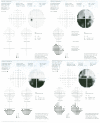The spectrum of optic disc ischemia in patients younger than 50 years (an Amercian Ophthalmological Society thesis)
- PMID: 24167327
- PMCID: PMC3799463
The spectrum of optic disc ischemia in patients younger than 50 years (an Amercian Ophthalmological Society thesis)
Abstract
Purpose: To identify the spectrum of clinical and fluorescein angiographic features of optic disc ischemia in patients younger than 50 years.
Methods: This retrospective comparative case series from a university consultative neuro-ophthalmology practice consisted of two phases. The first compared 108 cases of nonarteritic anterior ischemic optic neuropathy in patients younger than 50 years (NAIONy) to a cohort of 108 cases in patients 50 years or older (NAIONo). Predisposing risk factors, fluorescein angiographic features, and clinical course were compared. In the second phase, 12 cases of diabetic papillopathy under age 50 were assessed by fluorescein angiographic criteria for evidence of optic disc ischemia and compared to patients with NAIONy.
Results: NAIONy comprised 108 (12.7%) of 848 NAION cases reviewed. Chronic renal failure with dialysis and migraine were more common in NAIONy. Fellow eye involvement rate was significantly higher for NAIONy patients (46/108, 42.6%) than for NAIONo patients (32/108, 29.6%). Fluorescein angiographic features of ischemia were documented in 44 (81.5%) of 54 eyes studied. In one case, these features were documented in pre-NAION edema. Diabetic papillopathy demonstrated delayed filling consistent with ischemia in 7 of 10 (70.0%), without significant visual field loss.
Conclusions: Ischemic optic neuropathy in patients younger than 50 years is not rare. Fellow eye involvement is more frequent in younger patients. Fluorescein angiography confirmation of impaired perfusion in multiple syndromes of optic neuropathy corroborates a spectrum of optic disc ischemia ranging from perfusion delay without visual loss to severely impaired perfusion and visual loss and incorporates optic neuropathies previously considered nonischemic.
Figures


















References
-
- Arnold AC. Ischemic optic neuropathy. In: Miller NR, Newman NJ, editors. Walsh & Hoyt’s Clinical Neuro-Ophthalmology. 6th ed. Vol. 1. Philadelphia, PA: Lippincott Williams & Wilkins; 2005. pp. 349–384.
-
- Spencer WH, Hoyt WF. A fatal case of giant-cell arteritis (temporal or cranial arteritis) with ocular involvement. Arch Ophthalmol. 1960;64(6):862–867.
-
- Henkind P, Charles NC, Pearson J. Histopathology of ischemic optic neuropathy. Am J Ophthalmol. 1970;69(1):78–90. - PubMed
-
- Knox DL, Duke JR. Slowly progressive ischemic optic neuropathy. A clinicopathologic case report. Trans Am Acad Ophthalmol Otolaryngol. 1971;75(5):1065–1068. - PubMed
Publication types
MeSH terms
LinkOut - more resources
Full Text Sources
